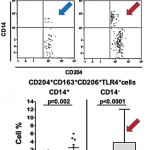Fibroblast-like synoviocytes promote C9 macrophage polarization that may drive pannus formation and tissue damage in RA-affected joints, said Dr. Ivashkiv. More study of the C9 growth factor pathways may lead to better understanding of how this destruction happens in RA.
Macrophage Sub-Types
There’s little information about cell markers to identify subtypes of synovial macrophages, said Ursula Fearon, PhD, professor of molecular rheumatology at Trinity College in Dublin, Ireland.
In an RA synovium, you see more macrophages than normal. CD68 macrophages are increased in clinically inflamed knee joints, for example. “No matter the therapy, DAS 28 score changes significantly correlate to subsets of macrophages in the joints,” Dr. Fearon said.
Macrophages from the synovium of active RA joints have a pro-inflammatory profile, and there is an increase in CD50 and CD36.6 In RA synovial fluid, M1 phenotypes are seen in higher amounts. Anti-citrullinated protein antibodies (ACPA) also affect how macrophage subtypes are distributed in joints, which could lead to RA, she said.7 Dr. Fearon and colleagues studied the macrophage subtypes in synovial biopsies of very inflamed joints, and also saw an increase in M1 macrophages.
“It’s difficult to define the markers of macrophage subtypes,” said Dr. Fearon. As far as targeting macrophages to develop therapies, “many patients don’t respond to these targets.”
Researchers are focusing on reprogramming to try to block the metabolic pathway in macrophages, an old idea that has come back around, she said.
GLUT-1 mediated glucose metabolism drives a pro-inflammatory macrophage phenotype. Pyruvate kinase M2, a key metabolic regulator, tetramerization inhibits Hif-1α IL-1ß, and promotes an M2 phenotype.8 “So that’s a possible therapeutic target,” she said. Metformin has also been shown to directly suppress macrophage phenotypes. So synovial macrophages clearly play a role in RA disease activity, and one day may be targeted in the joint environment as a therapy, she said.
Turning Off Macrophages
“The function of a macrophage is to protect us from infection or injury,” said Andy Clark, PhD, professor of inflammation biology at the University of Birmingham in the United Kingdom. “When it detects one of these potentially harmful events, it responds by producing pro-inflammatory cytokines like TNF.”
Normally, this response is tightly regulated, he said. The macrophage returns to its resting state and stops producing TNF. However, “in the rheumatoid synovium, it looks as though macrophages have forgotten how to switch off. We need to understand how these on and off switches work, and why they sometimes don’t operate correctly.”
